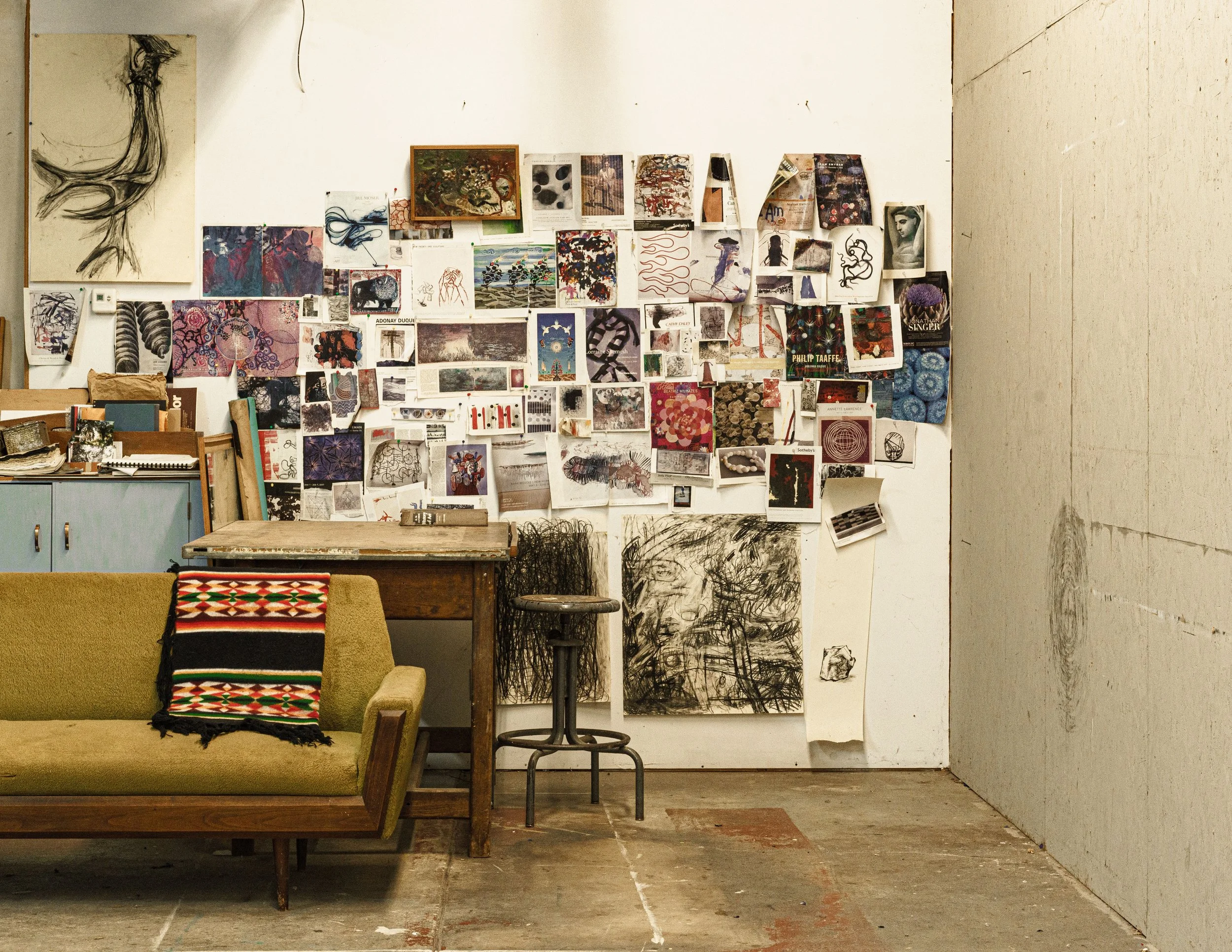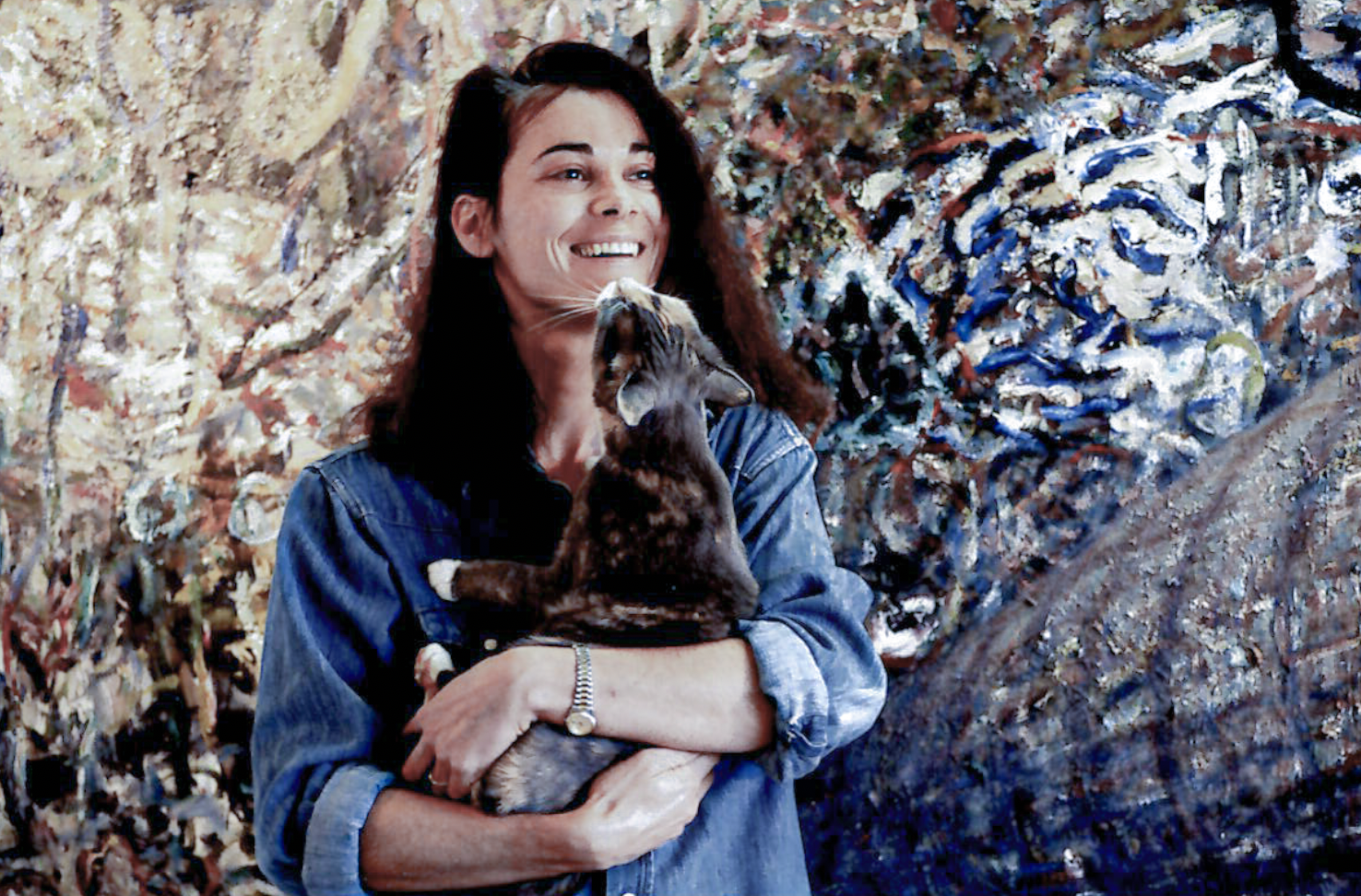An American Expressionist Artist
1955 - 2020
Romey was lost to brain cancer on November 24, 2020. She left a legacy of Art for the world to behold. In the studio she left behind, exists hundreds of drawings and many large scale paintings.
For over 30 years, Romey created fine art in both painting and drawing. In 1995, she also began practicing Neurolink and Holographic Repatterning therapies, which she remained deeply involved with throughout her life. This practice and belief system morphed into her artistic expression.
“[This was] Romey Stuckart’s lifelong work,” Ben Mitchell of Publication wrote in his essay of Romey’s work. “Her journey was mapped out by parallel paths: One art, her paintings and drawings; the other her immersion in the healing arts,” he continued.
“This morning the old apple trees in the orchard outside my window throw shadows across the frost-tinged grass in the early winter sunlight. Rows of delicate forms, like a subtle calligraphy in a language just beyond my understanding. Silent, unexpected, surprising, the resonance of the physical world. Being attuned and responsive to this resonance—or presence or aura or energy, you choose.”

Above, an inspiration wall in Romey’s studio—art magazine clippings…mixed with small drawings and paintings created by her...
She was born Rosemary Stuckart in 1955 in Sublimity, Oregon, the fifth of six children. Her father had a sawmill and trucking company. She and her siblings worked in the mill when old enough and all attended Catholic schools.
Romey earned a B.A. from Gonzaga University and an MFA from the University of Iowa, Iowa City. She went on to teach Art at the University of Iowa and it was there, that she met her lifelong love.
She married artist Stephen Schultz in 1984 and immediately embarked upon traveling abroad with him.
New York was their first stop, they lived and worked there, as they marinated in the culture of the Arts. Together, they moved forward participating in international art fellowships and as visiting artists around the world.
Their travels led them from Italy, France and Spain, to Egypt, Thailand and India. They drifted along the waters of Lake Como, The Seine, The Mediterranean, The Nile and The Indian. Kally Thurman, Friend and Curato,r writes, “Throughout their journeys, they painted in well-appointed to makeshift spaces, where they flourished and the work spoke.”
The couple moved to Hope, Idaho in 1987, where they submersed themselves in their individual creations of large bodies of artwork. It was here that many of Romey’s most profound Landscape Paintings were born. She fell in love with nature and the depth of the Idaho Woodlands and explored deep interpretations of her surrounding ecosystem and the translation of this into an energetic experience.
At the same time, she also received back-to-back fellowships from the Guggenheim Foundation and the National Endowment for the Arts in 1992 and 1993. Romey’s work evokes varying emotional responses, as shown in the juxtaposition between Ben Mitchell’s essay and the review below by The Los Angeles Times.
A REVIEWER FROM LOS ANGELES TIMES WRITES—“In Stuckart’s hands, the genre acquire the formal eccentricities of Surrealism and a twist of 20th-Century Angst.
Colors are not exactly natural, they’re exaggerated or invented, as in the rainbow veneer she gives the bark of fallen branches, or the inexplicable blue shadows that give foliage a threatening bite. The artist keeps her colors very warm, mixing them with lots of red and orange to make scenes vibrate with energy. Her arrangement of space is believable enough to pass for naturalism, but closer consideration reveals the artist’s selective imagination at work—
—In “Dry Creek Basin,” the twigs of a bare tree trunk plunked in the foreground block our entry point like weapons or sentinels, and in “Bone Yard” a tree leveled to a jagged stump by some violent force is about as cozy as a bed of glass shards. In just about every work, tangled boughs, dark pools, and boulders suggest inanimate nature about to come to life. Just beyond this barrier of seductive, yet off-putting nature we spy an intense, inviting glow. It’s almost too obvious that these aren’t literal landscapes but metaphor for life’s sublime yet rocky course. (Market Street Gallery, 48 Market St.) —M.D.
Romey and Stephen moved from Hope to Sandpoint in 2000. They renovated an old machine shop in the heart of Sandpoint and created a contemporary live-work environment with ample room for both artists to create. From 2000 on, she embarked upon her own solo exploration, traveling both nationally and internationally. She spent a majority of the year living in California but traveled back and forth to her home in Sandpoint with Stephen. Ultimately, it is where she spent the end of her days in peaceful rest…surrounded by loved ones.
When speaking of Romey Stuckart’s Painting and Drawing, Ben Mitchell wrote, “Stuckart’s paintings are alive. There’s an intimacy, an understanding of being in a place and experiencing it. And they are hard won.
“The formal elements lead the viewer into the place. Strong diagonals guide the eye into the picture plane. Lush and surprising interplay of colors invite the viewer. You are transported. Painting and seeing become an act of participation, inviting us into her experience with the places where she lived and worked hard to get to—hiking along Denton Slough at the mouth of the Clark Fork River, up Riser and Trestle Creeks, Bee Top Mountain, Cougar Peak. Places suffused with smells and tastes and textures and the astonishing arrays of color and pattern and the motion she found there. In her paintings she is saying: ‘Here, here I am.’
“The dynamic of light and color, of surface and depth, an intersection of the perceived external world—the wild, visually complex, and chaotic northern Idaho deep woods, mountain streams, and the grandeur of Lake Pend Oreille— and the human response to that world through emotion, intuition, and insight, this was her work.”
Romey described, “The paintings are initiated by a feeling akin to knowing something just on the tip of my tongue—a teasing just beyond me. The process involves a listening inward, a dance of faith and anxiety coaxing into view this visual reference for what we almost know.”
Ben Mitchell continued, “She always made a space for the imagination. It is as if she possessed a pearl of intellect surrounded by a luminescent shell of intuition… And as regards intuition, her drawings are another world entirely.”
“The drawings capture an artist at work, asking questions not about what is going to happen next in the piece—rather, accepting an unforeseen outcome, the unpremeditated act of drawing: fresh, transparent, raw, honest.”




